

The Neanderthal Legacy: An Archaeological Perspective from Western Europe

The Neanderthals populated western Europe from nearly 250,000 to 30,000 years ago when they disappeared from the archaeological record. In turn, populations of anatomically modern humans, Homo sapiens, came to dominate the area. Seeking to understand the nature of this replacement, which has become a hotly debated issue, Paul Mellars brings together an unprecedented amount of information on the behavior of Neanderthals. His comprehensive overview ranges from the evidence of tool manufacture and related patterns of lithic technology, through the issues of subsistence and settlement patterns, to the more controversial evidence for social organization, cognition, and intelligence. Mellars argues that previous attempts to characterize Neanderthal behavior as either "modern" or "ape-like" are both overstatements. We can better comprehend the replacement of Neanderthals, he maintains, by concentrating on the social and demographic structure of Neanderthal populations and on their specific adaptations to the harsh ecological conditions of the last glaciation.
Mellars's approach to these issues is grounded firmly in his archaeological evidence. He illustrates the implications of these findings by drawing from the methods of comparative socioecology, primate studies, and Pleistocene paleoecology. The book provides a detailed review of the climatic and environmental background to Neanderthal occupation in Europe, and of the currently topical issues of the behavioral and biological transition from Neanderthal to fully "modern" populations.
About the Author
Paul Mellars is both Reader in Prehistory and President of Corpus Christi College of the University of Cambridge. He is the editor, with Christopher Stringer, of The Human Revolution: Behavioral and Biological Perspectives on the Origins of Modern Humans (Princeton).
Paperback: 480 pages
Publisher: Princeton University Press; Reprint edition (July 28, 2015)
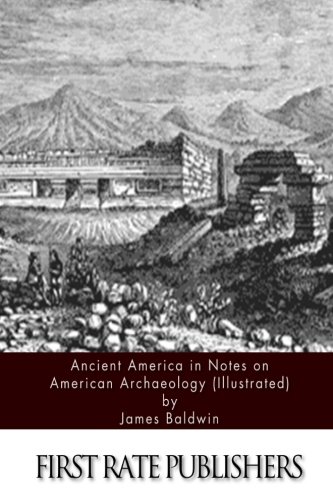

Ancient America, in Notes on American Archaeology (Illustrated)

“If, as seems most likely, there was in South America an ancient development of civilized human life, out of which arose the civilizations found in Peru and Central America, its antiquity was much greater than can be comprehended by the current chronologies.” -John D. Baldwin, a confidant to many notable thinkers of his time, including Ralph Waldo Emerson, Charles Darwin, James Russell Lowell, and particularly his friend Charles Sumner.
John D. Baldwin asserts that the origins of human civilization arose among an Arabian or Northeast African people, the Cushites, in pre-historic times.
CONTENTS.
- I. ANCIENT AMERICA.—THE MOUND-BUILDERS Works of the Mound-Builders. Extent of their Settlements. Their Civilization. Their Ancient Mining Works.
- II. ANTIQUITY OF THE MOUND-BUILDERS How long were they here?
- III. WHO WERE THE MOUND-BUILDERS? Not Ancestors of the Wild Indians. Brereton’s Story. American Ethnology. Who the Mound-Builders were.
- IV. MEXICO AND CENTRAL AMERICA Their Northern Remains. The “Seven Cities of Cevola.” Central Mexico. The great Ruins at the South.
- V. MEXICO AND CENTRAL AMERICA Palenque. Copan and Quiragua. Mitla. An Astronomical Monument. Ruins farther South. The Ruins in Yucatan. Mayapan. Uxmal. Kabah. Chichen-Itza. Other Ruins.
- VI. ANTIQUITY OF THE RUINS Distinct Eras traced. Nothing perishable left. “The Oldest of Civilizations.” American Cities seen by Tyrians.
- VII. WHENCE CAME THIS CIVILIZATION? The “Lost Tribes of Israel.” The “Malay” Theory. The Phœnician Theory. The “Atlantic” Theory. It was an original Civilization.
- VIII. AMERICAN ANCIENT HISTORY The Old Books not all lost. The Ancient History sketched. The Toltecs our Mound-Builders. Some confirmation of the History
- IX. THE AZTEC CIVILIZATION The Discovery and Invasion. The City of Mexico. The Conquest. Who were the Aztecs? They came from the South.
- X. ANCIENT PERU The Spanish Hunt for Peru. The Ruins near Lake Titicaca. Other Ruins in Peru. The great Peruvian Roads. The Peruvian Civilization.
- XI. PERUVIAN ANCIENT HISTORY Garcilasso’s History. Fernando Montesinos. His Scheme of Peruvian History. Probabilities. Conclusion.
- APPENDIX.
- A. The Northmen in America.
- B. The Welsh in America.
- C. Antiquities of the Pacific Islands.
- D. Deciphering the Inscriptions
About the Author
Dr. Baldwin is a native of Alabama and received his B.A. in History from Talladega College. He then received an M.A. degree in Black Church Studies followed by a M.Div. degree in Theology at Colgate-Rochester Divinity School in Rochester, New York. In 1980 Dr. Baldwin earned a Ph.D. degree in American Christianity from Northwestern University. He has taught at Wooster College in Ohio, Colgate University in New York, Colgate-Rochester Divinity School and currently is Professor in Religious Studies at Vanderbilt University. Dr. Baldwin is the author of over sixty articles and several books, and he and his wife live in Nashville, TN. --This text refers to an out of print or unavailable edition of this title.
Paperback: 134 pages
Publisher: CreateSpace Independent Publishing Platform (March 23, 2015)
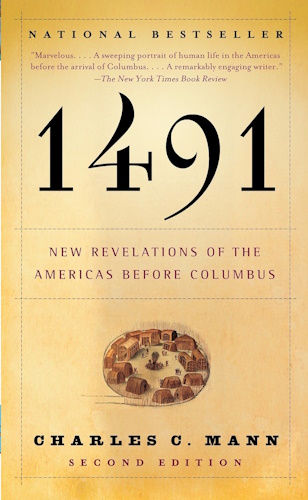

1491: New Revelations of the Americas Before Columbus

In this groundbreaking work of science, history, and archaeology, Charles C. Mann radically alters our understanding of the Americas before the arrival of Columbus in 1492.
Contrary to what so many Americans learn in school, the pre-Columbian Indians were not sparsely settled in a pristine wilderness; rather, there were huge numbers of Indians who actively molded and influenced the land around them. The astonishing Aztec capital of Tenochtitlan had running water and immaculately clean streets, and was larger than any contemporary European city. Mexican cultures created corn in a specialized breeding process that it has been called man’s first feat of genetic engineering. Indeed, Indians were not living lightly on the land but were landscaping and manipulating their world in ways that we are only now beginning to understand. Challenging and surprising, this a transformative new look at a rich and fascinating world we only thought we knew.
About the Author
Charles C. Mann, a correspondent for The Atlantic, Science, and Wired, has written for Fortune, The New York Times, Smithsonian, Technology Review, Vanity Fair, and The Washington Post, as well as for the TV network HBO and the series Law & Order. A three-time National Magazine Award finalist, he is the recipient of writing awards from the American Bar Association, the American Institute of Physics, the Alfred P. Sloan Foundation, and the Lannan Foundation. His 1491 won the National Academies Communication Award for the best book of the year. He lives in Amherst, Massachusetts.
Paperback: 541 pages
Publisher: Vintage Books; 1st edition (October 10, 2006)
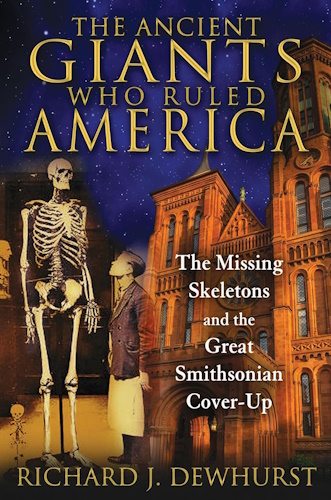

The Ancient Giants Who Ruled America

A study of the substantial evidence for a former race of giants in North America and its 150-year suppression by the Smithsonian Institution
- • Shows how thousands of giant skeletons have been found, particularly in the Mississippi Valley, as well as the ruins of the giants’ cities
- • Explores 400 years of giant finds, including newspaper articles, first person accounts, state historical records, and illustrated field reports
- • Reveals the Stonehenge-era megalithic burial complex on Catalina Island with over 4,000 giant skeletons, including kings more than 9 feet tall
- • Includes more than 100 rare photographs and illustrations of the lost evidence
Drawing on 400 years of newspaper articles and photos, first person accounts, state historical records, and illustrated field reports, Richard J. Dewhurst reveals not only that North America was once ruled by an advanced race of giants but also that the Smithsonian has been actively suppressing the physical evidence for nearly 150 years. He shows how thousands of giant skeletons have been unearthed at Mound Builder sites across the continent, only to disappear from the historical record. He examines other concealed giant discoveries, such as the giant mummies found in Spirit Cave, Nevada, wrapped in fine textiles and dating to 8000 BCE; the hundreds of red-haired bog mummies found at sinkhole “cenotes” on the west coast of Florida and dating to 7500 BCE; and the ruins of the giants’ cities with populations in excess of 100,000 in Arizona, Oklahoma, Alabama, and Louisiana.
Dewhurst shows how this suppression began shortly after the Civil War and transformed into an outright cover-up in 1879 when Major John Wesley Powell was appointed Smithsonian director, launching a strict pro-evolution, pro-Manifest Destiny agenda. He also reveals the 1920s’ discovery on Catalina Island of a megalithic burial complex with 6,000 years of continuous burials and over 4,000 skeletons, including a succession of kings and queens, some more than 9 feet tall--the evidence for which is hidden in the restricted-access evidence rooms at the Smithsonian.
About the Author
Richard J. Dewhurst is the Emmy Award-winning writer of the HBO feature documentary Dear America: Letters Home from Vietnam. A graduate of NYU with degrees in journalism, film, and television, he has written and edited for the History Channel, the Arts & Entertainment Channel, PBS, Fox Television and Fox Films, ABC News, TNT, Paramount Pictures, and the Miami Herald. He lives in Vermont.
Paperback: 368 pages
Publisher: Bear & Company; 1 edition (December 27, 2013)
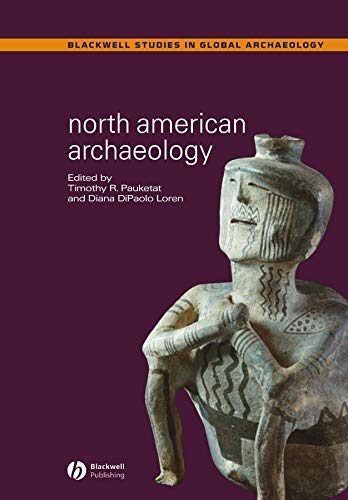

This volume offers a rich and informative introduction to North American archaeology for all those interested in the history and culture of North American natives.
- Organized around central topics and debates within the discipline.
- Illustrated with case studies based on the lives of real people, to emphasize human agency, cultural practice, the body, issues of inequality, and the politics of archaeological practice.
- Highlights current understandings of cultural and historical processes in North America and situates these understandings within a global perspective.
Paperback: 416 pages
Publisher: Wiley-Blackwell; 1 edition (December 27, 2004)
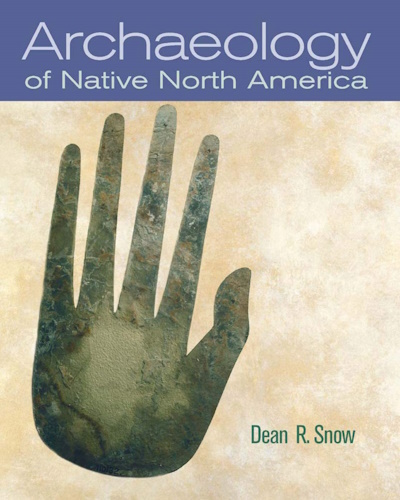

Archaeology of Native North America

This comprehensive text is intended for the junior-senior level course in North American Archaeology. Written by accomplished scholar Dean Snow, this new text approaches native North America from the perspective of evolutionary ecology. Succinct, streamlined chapters present an extensive groundwork for supplementary material, or serve as a core text.The narrative covers all of Mesoamerica, and explicates the links between the part of North America covered by the United States and Canada and the portions covered by Mexico, Guatemala, Belize, and the Greater Antilles. Additionally, book is extensively illustrated with the author's own research and findings.
About the Author
Dean R. Snow is Professor Emeritus of Anthropology at Penn State University. He is an archaeologist who specializes in ethnohistoric and demographic problems. In recent years his work has led him into Geographic Information Systems (GIS) approaches to these issues. He has conducted research in Mexico and in the northeastern region of North America, where his work on the Iroquois is particularly well known. His current research includes cyberinfrastructure and the development of large GIS databases designed to explore large-scale population movements over time and space. He is also currently researching the sexual dimorphism of human handprints and hand stencils in the Upper Paleolithic caves of France and Spain.
Paperback: 408 pages
Publisher: Routledge; 1 edition (October 1, 2009)
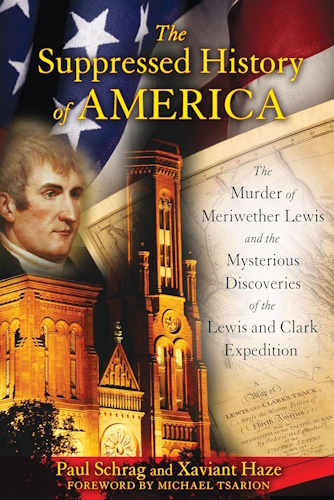

The Suppressed History of America

An investigation into the discoveries of Lewis and Clark and other early explorers of America and the terrible acts committed to suppress them
- • Provides archaeological proof of giants, the fountain of youth, and descriptions from Lewis’s journals of a tribe of “nearly white, blue-eyed” Indians
- • Uncovers evidence of explorers from Europe and Asia prior to Columbus and of ancient civilizations in North America and the Caribbean
- • Investigates the Smithsonian conspiracy to cover up Lewis and Clark’s discoveries and what lead to Lewis’s murder
Meriwether Lewis discovered far more than the history books tell--ancient civilizations, strange monuments, “nearly white, blue-eyed” Indians, and evidence that the American continent was visited long before the first European settlers arrived. And he was murdered to keep it all secret.
Examining the shadows and cracks between America’s official version of history, Xaviant Haze and Paul Schrag propose that the America of old taught in schools is not the America that was discovered by Lewis and Clark and other early explorers. Investigating the discoveries of Spanish conquistadors and Olmec stories of contact with European-like natives, the authors uncover evidence of explorers from Europe and Asia prior to Columbus, sophisticated ancient civilizations in North America and the Caribbean, the fountain of youth, and a long-extinct race of giants. Verifying stories from Lewis’s journals with modern archaeological finds, geological studies, 18th- and 19th-century newspapers, and accounts of the world in the days of Columbus, the authors reveal how Lewis and Clark’s finds infuriated powerful interests in Washington--including the Smithsonian Institution--culminating in the murder of Meriwether Lewis.
About the Author
PAUL SCHRAG is an award-winning journalist, novelist, marketing and business consultant, photographer, and musician. XAVIANT HAZE is a freelance researcher of ancient manuscripts and alternative history. His career as a music producer and DJ allows him to travel the world, exploring and documenting his findings on lost cities and the myths of the pre-diluvian world. Both authors live in Tacoma, Washington.
Paperback: 176 pages
Publisher: Bear & Company; F First Edition edition (May 20, 2011)
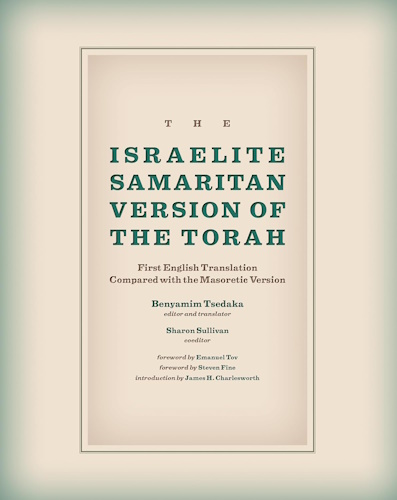

The Israelite Samaritan Version of the Torah

This landmark volume presents the first-ever English translation of the ancient Israelite Samaritan version of the Pentateuch, or Torah. A text of growing interest and importance in the field of biblical studies, the Samaritan Pentateuch preserves a version of the Hebrew text distinct from the traditional Masoretic Text that underlies modern Bible translations.
Benyamim Tsedaka's expert English translation of the Samaritan Pentateuch is here laid out parallel to the more familiar Masoretic Text, highlighting the more than 6,000 differences between the two versions. In addition to extensive explanatory notes in the margins throughout, the book's detailed appendices show affinities between the Samaritan and Septuagint versions and between the Samaritan and Dead Sea Scroll texts. Concluding the volume is a categorical name index containing a wealth of comparative information.
About the Author
Benyamim Tsedaka is head of the A. B. Institute ofSamaritan Studies in Holon, Israel, and founding editor of abiweekly Samaritan newsmagazine published in four languages.
Hardcover: 558 pages
Publisher: Eerdmans; 1St Edition edition (April 26, 2013)
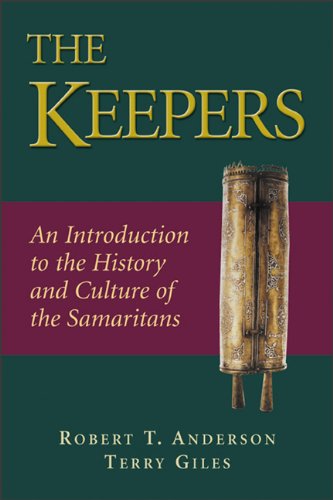

The Keepers: An Introduction to the History and Culture of the Samaritans

The Keepers describes the remarkable history and survival of the Samaritans and the unique oppression and grace that have shaped their culture and religion. It is a history whose antagonists have included Jews, Christians, and Muslims, and it has contributed to arguments between Roman Catholics and Protestants over the text of the Bible. The threads of the story disappear at times into Judaism, Christianity, and Islam, but ultimately succeed in affirming the unique Samaritan identity. Popularly associated with phrases like "The Lost Ten Tribes of Israel" and "The Good Samaritan," many are surprised to learn that the Samaritans have a rich history and culture that includes a contemporary chapter. This history is illuminated by stories in the Hebrew Bible and documents from Persian, Greek, Roman, Byzantine, and Islamic sources.
About the Author
Robert T. Anderson, author of Samaritan Manuscripts and Artifacts, is professor emeritus of religious studies at Michigan State University.
Terry Giles teaches biblical studies as professor of theology at Gannon University. He has also been active in higher education administration and served as guest teaching faculty in Europe, Asia, and Africa.
Hardcover: 192 pages
Publisher: Baker Academic (December 1, 2001)


Jews and Samaritans: The Origins and History of Their Early Relations

Winner of the R.B.Y. Scott Award from the Canadian Society of Biblical Studies
Even in antiquity, writers were intrigued by the origins of the people called Samaritans, living in the region of ancient Samaria (near modern Nablus). The Samaritans practiced a religion almost identical to Judaism and shared a common set of scriptures. Yet the Samaritans and Jews had little to do with each other. In a famous New Testament passage about an encounter between Jesus and a Samaritan woman, the author writes, "Jews do not share things in common with Samaritans."
The Samaritans claimed to be descendants of the northern tribes of Joseph. Classical Jewish writers said, however, that they were either of foreign origin or the product of intermarriages between the few remaining northern Israelites and polytheistic foreign settlers. Some modern scholars have accepted one or the other of these ancient theories. Others have avidly debated the time and context in which the two groups split apart.
Covering over a thousand years of history, this book makes an important contribution to the fields of Jewish studies, biblical studies, ancient Near Eastern studies, Samaritan studies, and early Christian history by challenging the oppositional paradigm that has traditionally characterized the historical relations between Jews and Samaritans.
About the Author
Gary Knoppers is the O'Brien Professor of Theology at University of Notre Dame. Recent publications include a two-volume commentary on I Chronicles in the Anchor Bible series (2004), a co-edited volume (with Bernard Levinson) on The Pentateuch as Torah (2007), and a co-edited volume (with Oded Lipschits and Manfred Oeming) on Judah and the Judeans in the Achaemenid Period (2011).
Hardcover: 352 pages
Publisher: Oxford University Press; 1 edition (May 30, 2013)
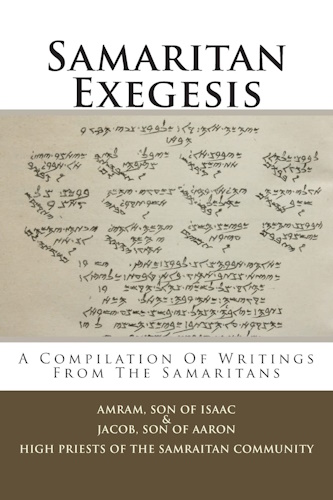

Samaritan Exegesis: A Compilation Of Writings From The Samaritans

This book is a compilation of writings from two Samaritan High Priests of the early 20th century. Both works layout the doctrine of the Samaritans with detailed explanations from the Torah. Mount Gerizim: The One True Sanctuary The Samaritans hold to the belief that Mount Gerizim is the sacred place which their worship and pilgrimage is to be directed to the rejection of the Jebusite mount of Jerusalem. Mount Gerizim plays a prominent role in the lives of the Patriarchs: Abraham, Isaac, and Jacob; is the place described in the Torah as the Mountain of Blessing; and was part of the inheritance of Jacob’s favored son Jospeh. Samaritan High Priest Amram son of Isaac lays out their claim that it is “The One True Sanctuary.” (Originally published in the early 1900’s) The Book Of Enlightenment For The Instruction Of The Inquirer Samaritan High Priest Jacob son of Aaron set out to answer twenty-five questions most frequently asked of him by outsiders as well as of those among his own community. He also set forth two arguments for his opponents - the Jews - which show the distance in doctrine between these two Israelite sects. (Originally published in 1913)
Paperback: 108 pages
Publisher: CreateSpace Independent Publishing Platform (March 15, 2013)
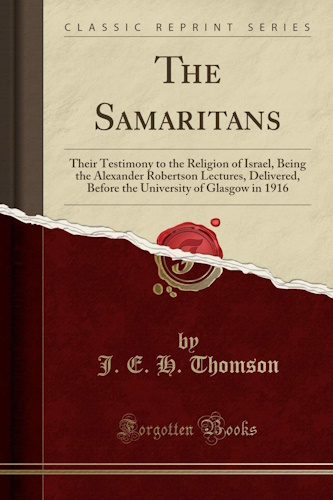

The Samaritans: Their Testimony to the Religion of Israel, Being the Alexander Robertson Lectures, Delivered, Before the University of Glasgow in 1916 (Classic Reprint)

Excerpt from The Samaritans: Their Testimony to the Religion of Israel, Being the Alexander Robertson Lectures, Delivered, Before the University of Glasgow in 1916
For assistance in correcting proof, the writer would return thanks to the Rev. Dr James Robertson, Professor emeritus of Oriental Languages, Glasgow University; Rev. Dr James Kennedy, Librarian, New College, Edinburgh; Dr John Hutchison, Rector emeritus, Glasgow High School; Rev. Dr Charles Jerdan, Greenock, Senior Clerk, u.b.c. General Assembly. He has further to thank the Rev. W. B. R. Wilson, Dollar, for compiling an index, and E. Russell, Esq, for general suggestions. The writer would also acknowledge the kindness of Professor W. B. Stevenson in bringing to his notice not a few facts and authorities, which might otherwise have escaped him; to Professor A. R. S. Kennedy for assistance in books; and to Dr Cowley, Oxford, for kind answers to inquiries in regard to matters, authoritative information on which was not open to the writer. He would express his gratitude to Dr Rendel Harris and to his friend the Rev. J. C. Nicol, m.a., Eccles, for information as to the Samaritan codices in the Rylands Library, Manchester. The kindness of the librarians of the Universities Of Glasgow and Edinbtirgh, and Of New College, Edinburgh, must not be forgotten. Above all he would tender his thanks to his wife for her assistance in preparing the manuscript for the Press.
In regard to books, the writer would acknowledge his indebtedness to Dr Montgomery's Samaritans, especially to the copious list Of literature appended to various articles of Dr Cowley, and to Dr Mill's Modern Samaritans.
About the Publisher
Forgotten Books publishes hundreds of thousands of rare and classic books. Find more at www.forgottenbooks.com
This book is a reproduction of an important historical work. Forgotten Books uses state-of-the-art technology to digitally reconstruct the work, preserving the original format whilst repairing imperfections present in the aged copy. In rare cases, an imperfection in the original, such as a blemish or missing page, may be replicated in our edition. We do, however, repair the vast majority of imperfections successfully; any imperfections that remain are intentionally left to preserve the state of such historical works.
Paperback: 454 pages
Publisher: Forgotten Books (February 7, 2018)
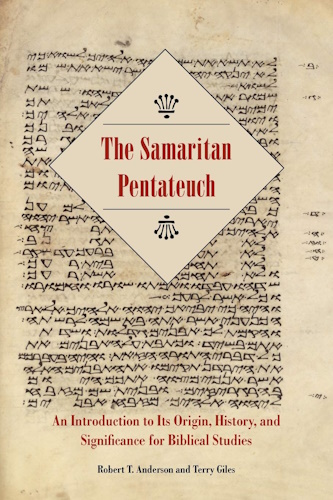

The Samaritan Pentateuch: An Introduction to Its Origin, History, and Significance

The Samaritan Pentateuch (SP) is the sacred scripture of the Samaritans, a tenacious religious community made famous by Jesus Good Samaritan story that persists to this day. Not so widely known is the impact of the SP outside the Samaritan community. Recently there has been a resurgence of interest in this scripture, as evidenced by several translations of the SP as well as reference in Qumran scroll studies to the SP or an SP-like tradition in an effort to describe some of the textual evidence present in the scrolls. This volume presents a general introduction to and overview of the SP, suitable for a course text and as a reference tool for the professional scholar.
About the Author
Robert T. Anderson is professor emeritus of religious studies at Michigan State University. Terry Giles teaches biblical studies as Professor of Theology at Gannon University. They are co-authors of The Keepers: An Introduction to the History and Culture of the Samaritans and Tradition Kept: The Literature of the Samaritans (both from Hendrickson).
Series: Sbl - Resources for Biblical Study (Paper)
Paperback: 236 pages
Publisher: Society of Biblical Literature (October 22, 2012)
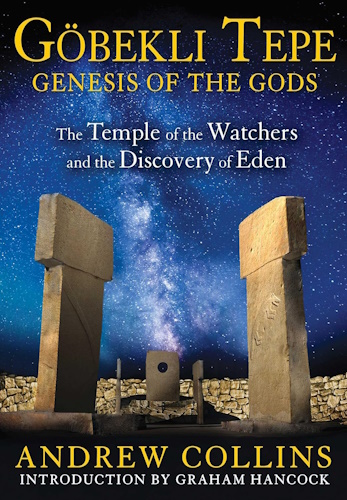

Gobekli Tepe: Genesis of the Gods: The Temple of the Watchers and the Discovery of Eden

An exploration of the megalithic complex at Göbekli Tepe, who built it, and how it gave rise to legends regarding the foundations of civilization
- Details the layout, architecture, and exquisite carvings at Göbekli Tepe
- Explores how it was built as a reaction to a global cataclysm
- Explains that it was the Watchers of the Book of Enoch and the Anunnaki gods of Sumerian tradition who created it
- Reveals the location of the remains of the Garden of Eden in the same region
Built at the end of the last ice age, the mysterious stone temple complex of Göbekli Tepe in Turkey is one of the greatest challenges to 21st century archaeology. As much as 7,000 years older than the Great Pyramid and Stonehenge, its strange buildings and rings of T-shaped monoliths--built with stones weighing from 10 to 15 tons--show a level of sophistication and artistic achievement unmatched until the rise of the great civilizations of the ancient world, Sumer, Egypt, and Babylon.
Chronicling his travels to Göbekli Tepe and surrounding sites, Andrew Collins details the layout, architecture, and exquisite relief carvings of ice age animals and human forms found at this 12,000-year-old megalithic complex, now recognized as the oldest stone architecture in the world. He explores how it was built as a reaction to a global cataclysm--the Great Flood in the Bible--and explains how it served as a gateway and map to the sky-world, the place of first creation, reached via a bright star in the constellation of Cygnus. He reveals those behind its construction as the Watchers of the Book of Enoch and the Anunnaki gods of Sumerian tradition.
Unveiling Göbekli Tepe’s foundational role in the rise of civilization, Collins shows how it is connected to humanity’s creation in the Garden of Eden and the secrets Adam passed to his son Seth, the founder of an angelic race called the Sethites. In his search for Adam’s legendary Cave of Treasures, the author discovers the Garden of Eden and the remains of the Tree of Life--in the same sacred region where Göbekli Tepe is being uncovered today.
About the Author
Andrew Collins has been investigating the idea of an advanced civilization existing before recorded history since 1979, focusing on southeast Turkey since the early 1990s. He is the co-discoverer of a massive cave complex beneath the Giza plateau, now known as “Collins’ Caves.” The author of From the Ashes of Angels, Gods of Eden, The Cygnus Mystery, and Gateway to Atlantis, he lives in Essex, England.
Paperback: 464 pages
Publisher: Bear & Company; 1 edition (May 1, 2014)
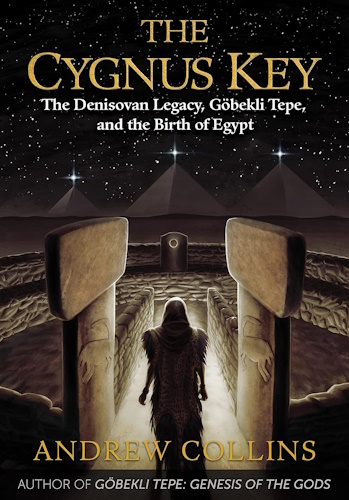

The Cygnus Key: The Denisovan Legacy, Göbekli Tepe, and the Birth of Egypt

New evidence showing that the earliest origins of human culture, religion, and technology derive from the lost world of the Denisovans
- Explains how Göbekli Tepe and the Giza pyramids are aligned with the constellation of Cygnus and show evidence of enhanced sound-acoustic technology
- Traces the origins of Göbekli Tepe and the Giza pyramids to the Denisovans, a previously unknown human population remembered in myth as a race of giants
- Shows how the ancient belief in Cygnus as the origin point for the human soul is as much as 45,000 years old and originally came from southern Siberia
Built at the end of the last ice age around 9600 BCE, Göbekli Tepe in southeast Turkey was designed to align with the constellation of the celestial swan, Cygnus--a fact confirmed by the discovery at the site of a tiny bone plaque carved with the three key stars of Cygnus. Remarkably, the three main pyramids at Giza in Egypt, including the Great Pyramid, align with the same three stars. But where did this ancient veneration of Cygnus come from?
Showing that Cygnus was once seen as a portal to the sky-world, Andrew Collins reveals how, at both sites, the attention toward this star group is linked with sound acoustics and the use of musical intervals “discovered” thousands of years later by the Greek mathematician Pythagoras. Collins traces these ideas as well as early advances in human technology and cosmology back to the Altai-Baikal region of Russian Siberia, where the cult of the swan flourished as much as 20,000 years ago. He shows how these concepts, including a complex numeric system based on long-term eclipse cycles, are derived from an extinct human population known as the Denisovans. Not only were they of exceptional size--the ancient giants of myth--but archaeological discoveries show that this previously unrecognized human population achieved an advanced level of culture, including the use of high-speed drilling techniques and the creation of musical instruments.
The author explains how the stars of Cygnus coincided with the turning point of the heavens at the moment the Denisovan legacy was handed to the first human societies in southern Siberia 45,000 years ago, catalyzing beliefs in swan ancestry and an understanding of Cygnus as the source of cosmic creation. It also led to powerful ideas involving the Milky Way’s Dark Rift, viewed as the Path of Souls and the sky-road shamans travel to reach the sky-world. He explores how their sound technology and ancient cosmologies were carried into the West, flowering first at Göbekli Tepe and then later in Egypt’s Nile Valley. Collins shows how the ancient belief in Cygnus as the source of creation can also be found in many other cultures around the world, further confirming the role played by the Denisovan legacy in the genesis of human civilization.
About the Author
Andrew Collins has been investigating the idea of advanced civilizations in prehistory since 1979. He is the co-discoverer of a massive cave complex beneath the Giza plateau, now known as “Collins’ Caves.” The author of several books, including From the Ashes of Angels and Gobekli Tepe: Genesis of the Gods, he lives in Essex, England.
Paperback: 464 pages
Publisher: Bear & Company (May 15, 2018)
![]()
![]()